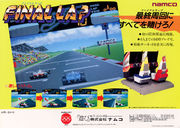Lost In Translation/Final Lap
| Final Lap | |
|---|---|
| Manufacturer | Namco |
| Released | 1987 |
| Control Method |
Paddle Pedal 1 Button(s) |
| Main CPU | (2x) 68000 (@ 12.288 MHz) M6809 (@ 3.072 MHz) HD63705 (@ 2.048 MHz) |
| Sound CPU | Stereo C140 (@ 21.390 kHz) YM2151 (@ 3.580 MHz) |
| Video Details |
Raster (Horizontal) 288 x 224 pixels 60.61 Hz 8,192 Palette colours |
| Screens | 1 |
| ROM Info | 22 ROMs 3,842,304 bytes (3.66 MiB) |
| MAME ID | finallap · finalapc · finalapd · finlapjb · finlapjc |
About The Game
Final Lap is a Formula One themed, chase-view arcade racing video game.
Featuring several courses, the gameplay is similar in feel to it's 1982 predecessor, "Pole Position", although the steering is much looser. Down shifting and brakes play major parts in keeping control of the car on the tight, winding courses. Bumping another car will not cause the player's car to explode - as in "Pole position" - but can send the player or the rival driver spinning off the track, costing valuable seconds.
Trivia
Licensed to Atari for US distribution
In 1990, Philip Morris, the tobacco conglomerate, filed a lawsuit claiming copyright infringement against Namco because this game featured a Marlboro billboard, which was found on the real-life Suzuka and Monaco tracks. Philip Morris was under investigation at the time for his role in the increase in pre-teen smoking and the appearance of one of his brands in games aimed towards children and teens did not help the company's already tarnished image. Namco was forced to pay a settlement.
Final Lap is the first multi-player, multi-cabinet networked arcade racing game. Multiple cabinets can be connected to allow up to eight players to join in the same race.
The upright game only has one pedal; releasing it readily decelerates the vehicle.
Victor Entertainment released a limited-edition soundtrack album for this game (Namco Video Game Graffiti Vol.4 - VDR-5282) on 08/03/1989.
Tips and tricks
A Trick To Get A Better Times
Play a multi-player game! In a multi-player game, the computer cars are less frequent and allow better lap times.
Series
- Pole Position [Upright model] (1982)
- Pole Position [Cockpit model] (1982)
- Pole Position II (1983)
- Final Lap (1987)
- Final Lap UR (1988)
- Final Lap Twin (1989, NEC PC-Engine)
- Final Lap 2 (1990)
- Final Lap 3 (1992)
- Final Lap R (1993)
- Final Lap 2000 (2000, Bandai WonderSwan)
- Final Lap Special (2001, Bandai WonderSwan Color)
Staff
- Music Composed By
- Shinji Hosoe
Cabinet and Artwork
Ports
- Consoles
- Nintendo Famicom (1988)
- Others
- LCD handheld game (1987) released by Namco
Soundtrack Releases
| Album Name | Catalogue No. | Released | Publisher | Comments |
|---|---|---|---|---|
| Namco Video Game Graffiti Volume 4 | VDR-5282[1] | 1989-03-08 | Victor | CD version. |
| Namco Video Game Graffiti Volume 4 | VCH-1907[2] | 1989-03-08 | Victor | Cassette version. |
| Namco Video Game Graffiti Volume 4 | SJX-25050[3] | 1989-03-08 | Victor | Vinyl version. |









